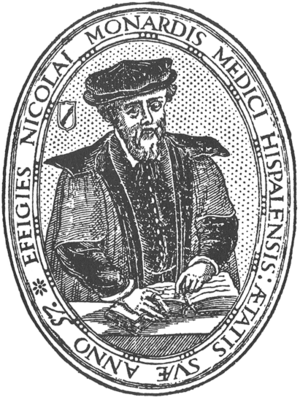Historia medicinal de las cosas que se traen de nuestras Indias Occidentales facts for kids
Historia medicinal de las cosas que se traen de nuestras Indias Occidentales is a famous book. Its name means "Medical study of products from our West Indian possessions." This book was written by Nicolás Monardes (1493–1588). He was a Spanish physician, which is a doctor, and a botanist, someone who studies plants.
Monardes' book was very important. It shared knowledge about new plants and other natural items. These items came from the Americas, often called the "New World" back then. People in Europe were very curious about these new discoveries. The book explained how these plants could be used as medicine.
Contents
About the Book
Nicolás Monardes first published his book in 1565. He kept adding more information to it over time. New editions came out in 1569 and 1574. The last edition was reprinted in 1580. Each new version had more details about the amazing plants and other things found in the Americas.
- The first edition in 1565 was called Dos libros. This means "Two Books."
- By 1574, the book had grown much larger. Its full title was very long! It covered many topics. These included medicinal plants, a special stone called bezoar, and a plant called escuerçonera. It also talked about iron and its uses, and even about snow and cold drinks.
Spreading the News: English Translation
The information in Monardes' book was so valuable that it was translated into other languages. An English version was made by John Frampton. He gave it a very interesting title: Joyful News out of the New Found World.
- The first English translation came out in 1577. It was based on Monardes' 1565 Spanish edition.
- A bigger English edition was published in 1580. This one included more information from Monardes' 1574 Spanish book.
- Later, in 1925, a new version of the English translation was made. It combined parts from both the 1577 and 1580 editions.
Spreading the News: Latin Translation
The book was also translated into Latin. Latin was a language used by many scholars and scientists across Europe. This translation helped spread Monardes' discoveries even further. Charles de l'Écluse, also known as Carolus Clusius, made the Latin version. He also added his own notes and comments.
- The first Latin translation appeared in 1574. It focused on the simple medicines from the West Indies.
- More revised Latin editions came out in 1579, 1582, 1593, and 1605. These versions often included more details and even illustrations. The 1605 edition was part of a larger collection of important works about plants.
See also
 In Spanish: Historia medicinal de las cosas que se traen de nuestras Indias Occidentales para niños
In Spanish: Historia medicinal de las cosas que se traen de nuestras Indias Occidentales para niños


